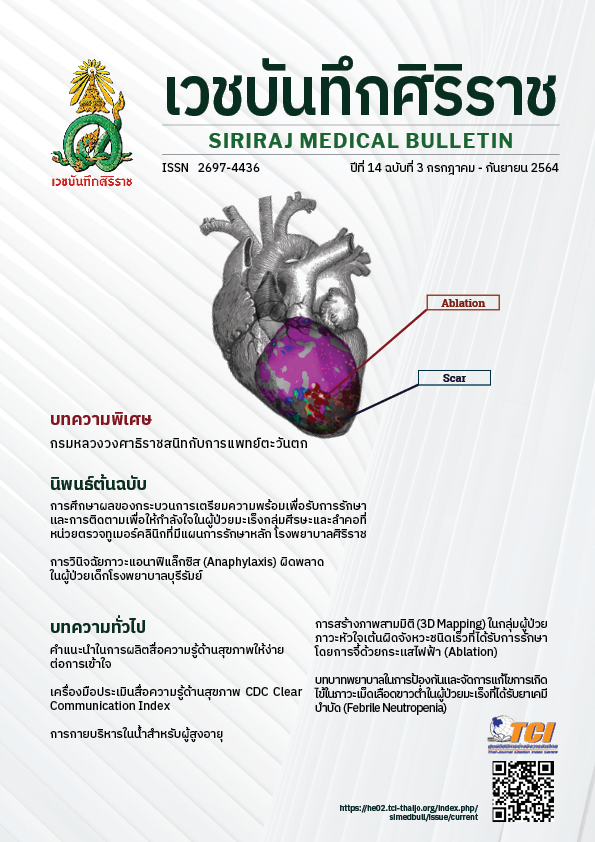Roles of Nurses in the Prevention and Management of the Febrile Neutropenia in Cancer Patients Undergoing Chemotherapy
Main Article Content
Abstract
Febrile neutropenia is the medical emergency of cancer that is commonly seen in cancer patients undergoing chemotherapy. This complication might lead to sepsis and septic shock, potentially resulting in patient mortality. Moreover, it could decrease the quality of life and lengthen the circle of care. The dosage reduction of the chemotherapy could bring about an ineffective result of the treatment and also increase the medical expenses. Therefore, nurses play an important role in this circumstance. Nurses are required to understand the definition of febrile neutropenia and its causal factors, periodically screen and assess the risks of febrile neutropenia in all cancer patients undergoing chemotherapy by using MASCC Risk Index for Febrile neutropenia along with the neutropenia level assessment. Additionally, nurses should follow the standard guideline in caring patients with febrile neutropenia as well as the nursing guideline in preventing and managing neutropenia in cancer patients undergoing chemotherapy. Nurses are supposed to possess knowledge in the dosage, management and the side effects of Granulocyte colony stimulating factor (G-CSF) in order to prevent febrile neutropenia. These capabilities would direct to an early appropriate nursing for a better result in patient care, the quality of life, and the safety of the patients.
Article Details
References
สุวรรณี สิริเลิศตระกูล, สุวลักษณ์ วงศ์จรรโลงศิล, ประไพ อริยประยูร, แม้นมนา จิระจรัส. การพยาบาลผู้ป่วยโรคมะเร็ง. พิมพ์ครั้งที่ 1. สมุทรปราการ: ห้างหุ้นส่วนจำกัดสินทวีกิจพริ้นติ้ง; 2555.
เพ็ญศรี รักษ์วงค์, กรแก้ว สุขวานิชย์เจริญ, จริยา เรียนวาที. ผลของการใช้แนวปฏิบัติทางการพยาบาลที่ใช้การจัดการ ความรู้เป็นฐานในการป้องกันการติดเชื้อในผู้ป่วยมะเร็งที่มีภาวะเม็ดเลือดขาวต่ำหลังได้รับการรักษาด้วยเคมีบำบัด. วารสารวิจัยสุขภาพและการพยาบาล 2563;2: 26-37.
พิจิตรา เล็กดำรงกุล. การประเมินความเสี่ยงและการจัดการการเกิดไข้ในภาวะเม็ดเลือดขาวต่ำในผู้ป่วยมะเร็งได้รับยาเคมีบำบัด. วารสารสภาการพยาบาล 2558;1: 5-12.
Naurois JD, Novitzky I, Gill MJ, Marti FM, Cullen MH, Roila F. Management of febrile neutropenia: ESMO clinical
practice guidelines. Annals of Oncology 2010;21: 252-6.
Chan A, Chen C, Chiang J, Tan S, Ng R. Incidence of febrile neutropenia among early-stage breast cancer patients receiving anthracycline-based chemotherapy. Supportive care in cancer 2012;20: 1525-32.
Lyman GH. Management of chemotherapy-induced neutropenia with colony-stimulating factor. Eur oncol 2008;1: 13-7.
ชัชวาล จตุปาริสุทธิ์, ศิริลักษณ์ อนันต์ณัฐศิริ. Febrile neutropenia. [อินเตอร์เน็ต]. 2556. [เข้าถึงเมื่อ 2564 ม.ค. 20] เข้าถึงได้จาก https://www.scribd.com/doc/Febrile-Neutropenia
Klastersky J, Paesmans M, Rubenstein EB, Boyer M, Elting L, Ronald F, et al. The multinational association for supportive care in cancer risk index: A multinational scoring system for identifying low-risk febrile neutropenic cancer patients. J Clin Oncol 2000;18: 3038-51
Marrs JA. Care of patients with neutropenia. Clinical Journal of Oncology Nursing 2006;10: 164-6.
กาญจนา จันทร์สูง. บทความฟื้นวิชา Management of febrile neutropenia. วารสารโลหิตวิทยาและเวชศาสตร์บริการโลหิต 2548;3: 185-91.
Bennett CL, Djulbegovic B, Norris LB, Armitage JO. Colony-stimuting factors for febrile neutropenia during cancer therapy. N Engl J Med 2013;368: 1131-9.
Lekdamrongkul P, Pongthavornkamol K, Chewapoonpon C, Siritanaratkul N. Factors associated with febrile neutropenia in acute leukemia patients receiving chemotherapy. J Nurs Sci 2009;27: 58-68.






